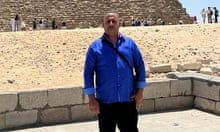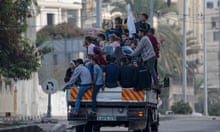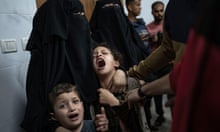Israeli forces have killed four Palestinians, including three teenagers, and shot more than 40 others at gatherings on the Gaza frontier marking the anniversary of the demonstration movement, the territory’s ministry of health said.
In an attempt to limit the huge numbers of casualties at previous rallies, Egypt has sought to broker an agreement between Israel and Hamas, which governs Gaza and has backed the protests.
Hamas officials said the group had agreed to prevent protesters approaching the fence and men in orange vests at the main encampments had worked to keep people back. In exchange, Israel would not fire on people who remained far from the frontier. Israel did not confirm that a deal had been reached but less live fire was heard than at previous rallies.
Israel’s military estimated that 40,000 demonstrators had turned up at several points along the border, adding that they threw rocks and in some cases “explosive devices” towards the fence.
The first fatality of the day, Muhammad Sa’ad, 20, was hit in the head by shrapnel caused by Israeli fire before dawn at an overnight protests before the main demonstration, Gaza’s health ministry said. Two 17-year-olds boys were shot dead later in the day, it said, while Belal al-Najjar, 17, later succumbed to wounds sustained in east Gaza Strip.
Israeli authorities did not immediately confirm or deny the deaths reported by Gaza officials.
The UN had urged Israel and Hamas to avoid a violent escalation on Saturday.
A committee that includes Hamas, and that organised the protest, released a statement calling for participants to keep the demonstration peaceful, to stay 200 metres from the perimeter – behind which Israeli forces are stationed – and not to burn tyres, a tactic used in previous events to obscure the sights of snipers.
On a blustery day, with showers, thousand turned out to the main site east of Gaza City. The Israeli army fired teargas canisters into the air. Fewer protesters appeared to be rushing towards the fence, as they had during previous events.
One Palestinian man, Samir al-Madhoun, 21, said he was there to demand the “right to a decent life; we do not want more than that”.
“We have suffered for more than 12 years. But what is our guilt?” he said, adding he had protested all year and would continue for another if needed.
Rasha al-Sa’di, 39, another demonstrator, said the year-long movement had made the world aware that “there are 2 million Palestinians suffering in Gaza”.
When the movement was first launched on 30 March 2018, Israeli soldiers shot dead 16 Palestinians. Demonstrators have demanded recognition of the right of Palestinian refugees in Gaza and elsewhere to return to their ancestral homes in Israel and for an end to a punishing decade-long blockade that they call a “siege”.
Weekly gatherings have diminished in size but continued for 12 months, despite the fact that none of the protesters’ demands were agreed to by Israel.
During that period, Israeli soldiers have killed 194 people – including three medics, two journalists and 40 children – and wounded close to 29,000 others. A quarter of all those injured – more than 7,000 people – had been shot with live ammunition, according to UN figures. More than 120 limb amputations have been carried out.
One member of the Israeli security forces has been killed and six others were injured in incidents related to the “Great March of Return”. Israel has dismissed the protests as a cover by militants to attack the fence, troops behind it and Israeli communities further back.
A UN commission tasked with investigating these claims found demonstrations were at times violent, with protesters hurling stones, surging forward and cutting through the fence. People have launched kites and balloons with incendiary devices attached to float into and burn Israeli fields.
However, it said the demonstrations were almost entirely civilian in nature and the use of lethal force against the protesters was neither necessary nor proportionate.
Israeli snipers, using high-velocity bullets with sophisticated optical scopes, may have committed war crimes by deliberately firing on civilians last year, the probe found. Many were hit hundreds of metres from the fences.
The sharpshooters, said one member of the UN independent inquiry, “shot at unarmed protesters, children and disabled persons, and at health workers and journalists performing their duties, knowing who they are”.
Bloodshed at the border has raised the prospect of further hostilities between Israel and Hamas, and the long-time enemies have fought multiple battles during the past year, often following particularly deadly protest days at the fence. Hamas fires rockets and mortars while Israel uses tanks and airstrikes.







